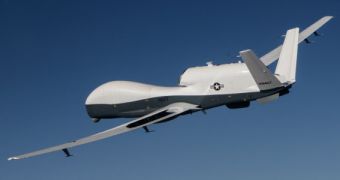Engineers at Northrop Grumman Corporation and Triumph Aerostructures – Vought Aircraft Division announce the successful testing of a wing structure that will go on the US Navy's Triton unmanned aircraft system (UAS).
During the tests, which were conducted at Triumph's Dallas facility, the wing assembly was subjected to loads that were 22 percent higher than the ones the Navy requested. During the investigation, engineers discovered no abnormalities or failures in the wing.
Resistant wings enable UAS to descend to low-altitudes whenever they are required, irrespective of the weather patterns below. In many cases, rapid positive identification of a target can mean the difference between success and failure in Navy missions.
The MQ-4C Triton UAS is destined to act as a complement to the Navy's P-8 Poseidon patrol aircraft, as a long-range reconnaissance, surveillance and intelligence asset. Testing of the entire airframe, including the wings, will begin as early as 2017.

 14 DAY TRIAL //
14 DAY TRIAL //